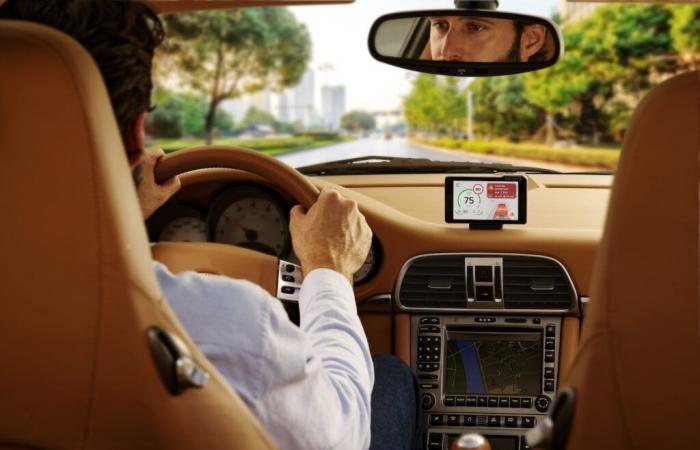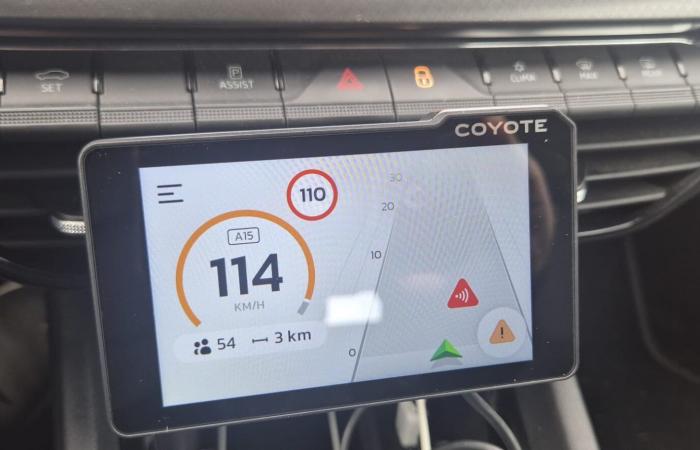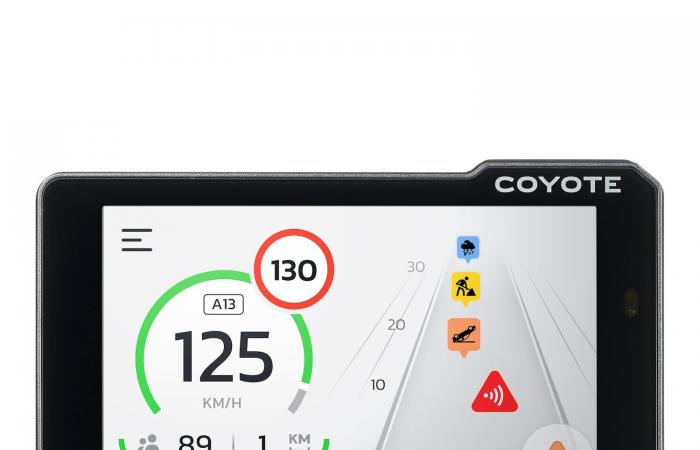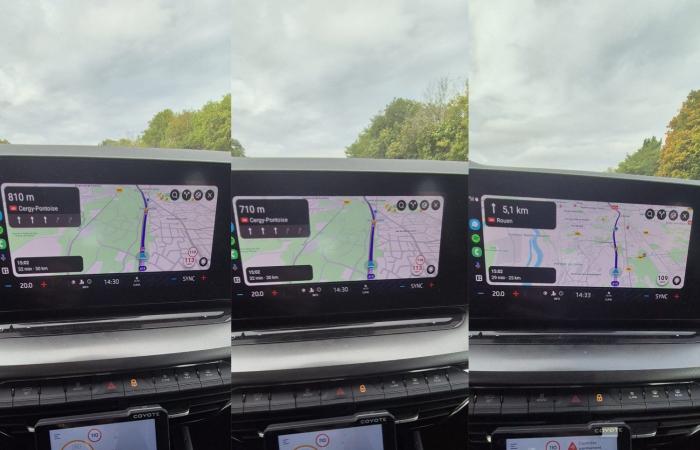Coyote, the road alert system, is not done with the hardware. The French brand has unveiled a new version of its case, the Max. New box that we were able to try for a month before its official release today. What is the new Coyote Max worth? Who is it aimed at? Is it better than the Coyote app or a simple Google Maps for navigation? Here is our first opinion on the driving aid reference.
Bigger, faster, more efficient
The biggest change in the Coyote Max is visible at first glance to someone familiar with the brand. It’s about size. The case has gained in screen diagonal and is now displayed in 4 inches. Featuring IPS technology (800 x 480), the screen has both better resolution and greater brightness. In fact, it is much more pleasant to use, even when the passenger compartment is bathed in light.
The case also gains in perceived quality. That is to say, it gives the impression of having been made with greater care and using stronger materials. The impression of a gadget that some of its predecessors could give is no longer relevant.
Coyote Max at the best price Base price: €299
See more offers
We also appreciated the full range of accessories available to connect or attach it in the most appropriate way, either to your vehicle or to your preferences when behind the wheel. On this point, it is also worth emphasizing the quality of the accessories offered by the French brand. As for the supports, for example, they have a magnet to ensure better support for the Coyote Max.
But, as is often the case, the most notable evolution is not visible, it is found under the surface and more particularly in the case where the French manufacturer has carried out a real revolution in its product. Certainly, the last version was starting to date and its technical sheet was pale, but the Coyote Max has still made some serious changes in this area.
The Coyote case took inspiration from the smartphone industry and opted for an eight-core processor (2 GHz) combined with 6 GB of RAM. It also integrates a 4G chip (it was only 3G until then) as well as multiband GPS and a ceramic antenna compatible with athermal windshields. Result: it is not only much more precise in terms of localization, but above all it is much faster and more responsive to use. From our point of view, this is one of the aspects that has evolved the most between the old range and the newcomer, and it is an understatement to say that this change was necessary.
A clearer, more readable and more pleasant interface
This is the other point on which Coyote has made significant progress. The road hazard warning has completely revised its interface. From visual icons to audible alerts, everything has changed on the Coyote Max. In reality, the evolution had started earlier this summer for the brand’s other boxes as well as the application, but it is on this latest model that it is most visible. The icons have been modernized, the colors reworked, the audible alert is no longer as tiring as before… In short, the new Coyote no longer gives the impression of being a slightly old-fashioned box and now has a well thought out and pleasant to use interface.

The Coyote Max every day
We used the Coyote Max for more than three weeks, both on urban trips and on longer, highway routes. The first impression, undoubtedly the most important, is that the quality of the case has really improved both in terms of its manufacturing and use. The larger screen, its resolution, the new interface, but also the fluidity of the menus contribute to a better user experience, undoubtedly one of the weak points of previous Coyote products.
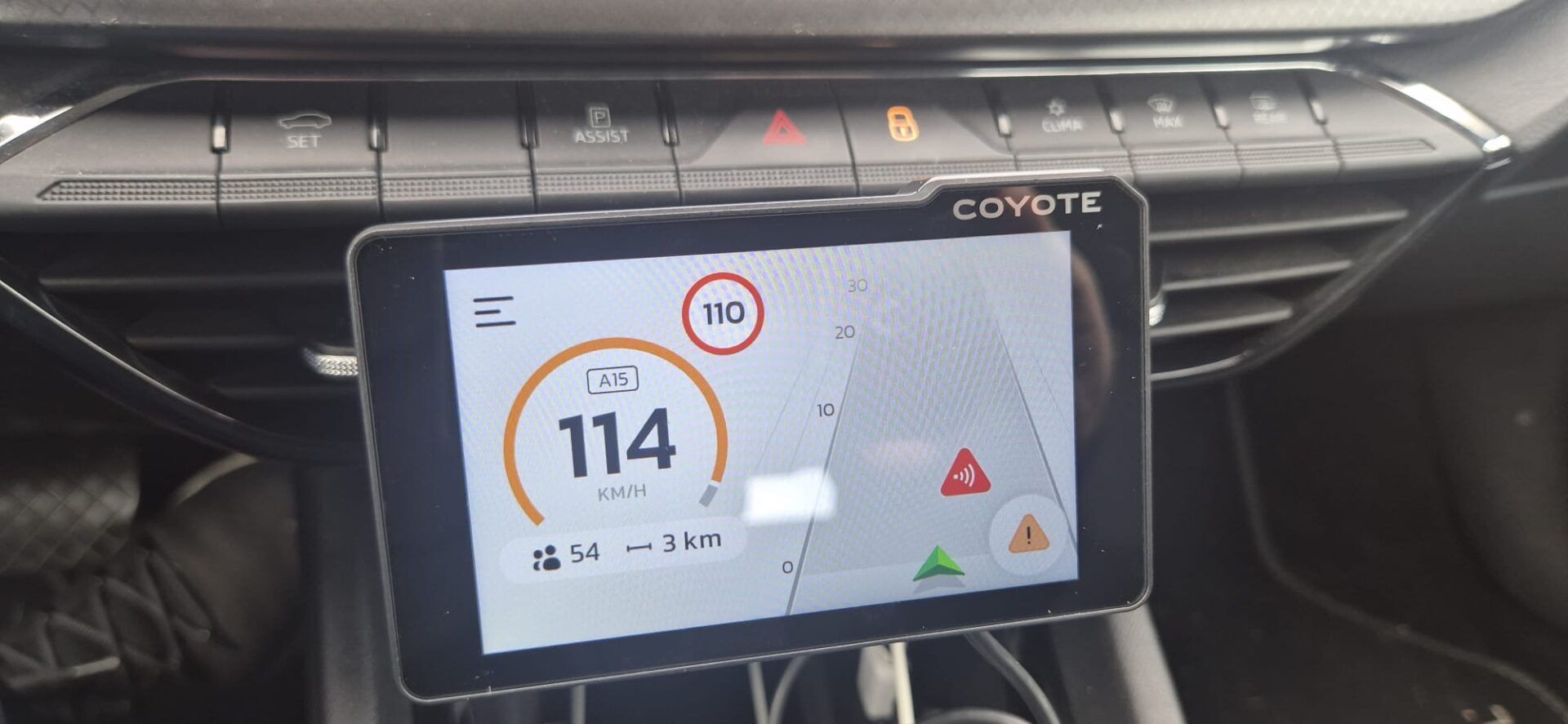
However, some weaknesses remain. If we appreciate, for example, the automatic startup of the Coyote Max when it is connected via USB, we regret the time required for this first startup. Nothing disastrous of course, but when leaving a motorway rest area, it is possible to travel 300 to 400 meters before actually starting. Among the small disappointments, we would also add the absence of precise signage concerning the direction of the danger reported. In its previous version, the Coyote interface indicated using an arrow the positioning (on its lane or the opposite lane) of the presence of danger. This is no longer the case and even if it is not a major absence, it is still notable.
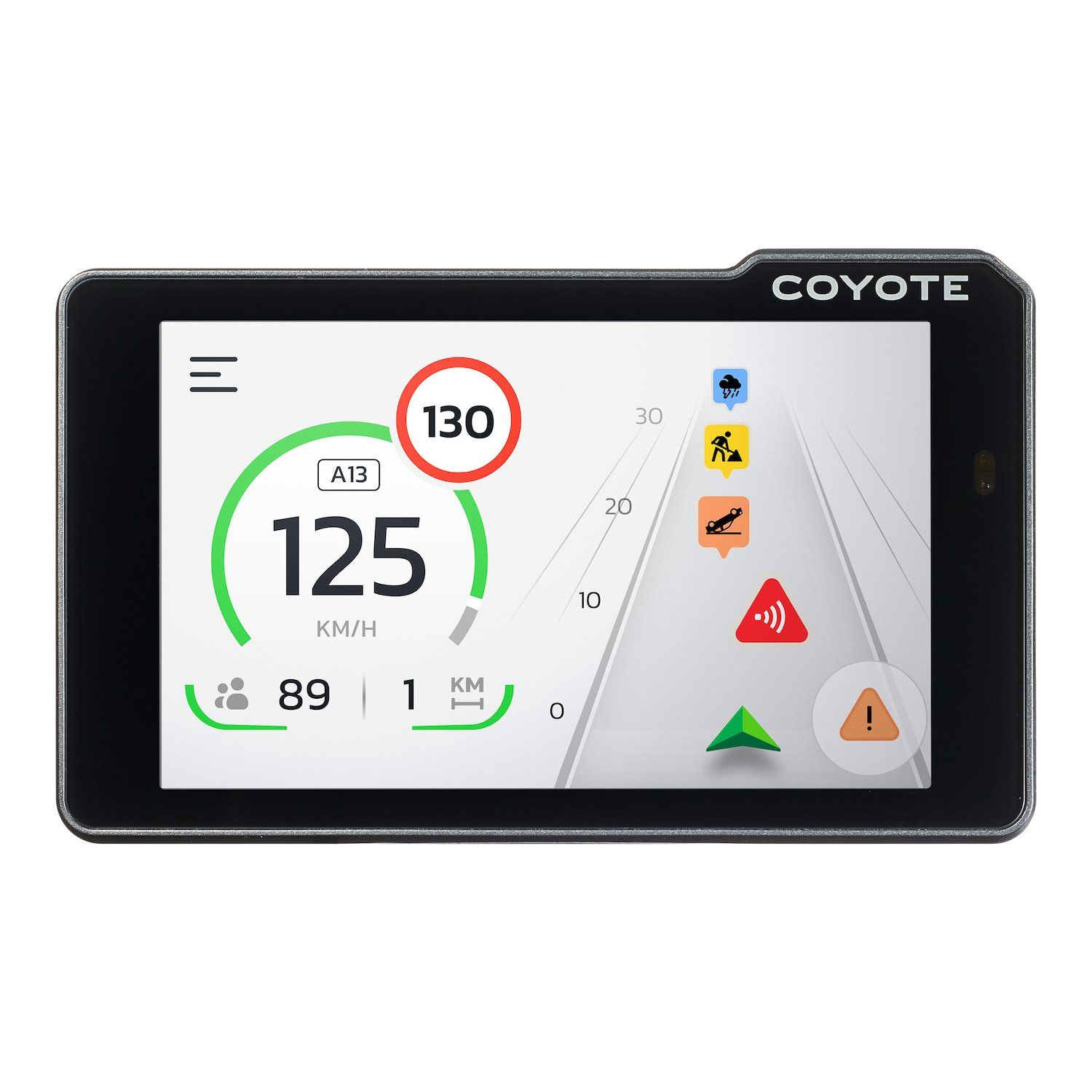
On the other hand, the box has become much more pleasant to use when it comes to confirming or denying an alert. From now on, a pop-up appears at the top of the screen asking the user to validate the information, deny it or simply indicate their uncertainty. Note that it is also possible to save yourself a hand gesture and confirm the presence or not of a radar (sorry of a danger) using the voice command.
As for the quality of the alerts, it is indisputable. The Coyote community is still functioning at full capacity and Coyote Max echoes it widely. On this subject, we are surprised that other competing applications or simply navigation tools have not integrated the “flash” of the screen, a very effective visual alert, particularly in the evening or at night or when lower the volume.
Is Coyote Max more effective than the app?
Testing the latest Coyote box should not avoid the question of its interest. To the extent that the French brand offers an equivalent, but more affordable, service via its application, it seems essential to us to compare the two to better understand the interest of the first.
If the Coyote Max has the advantage of offering a dedicated display, which can also be associated with navigation on your smartphone, and superior comfort of use, it does not really allow you to go further than the application . In this sense, the price required for its acquisition makes it significantly less competitive. Indeed, to the 299 euros necessary for its purchase, you must add a monthly subscription of 14.99 euros per month (or 179 euros per year). In comparison, the Coyote application available on iOS and Android is billed at 9.99 euros per month or 14.99 euros with the CarPlay and Android Auto option. This first comparison does not work in favor of the Coyote Max, especially since there is no difference in the alerts between the two devices.
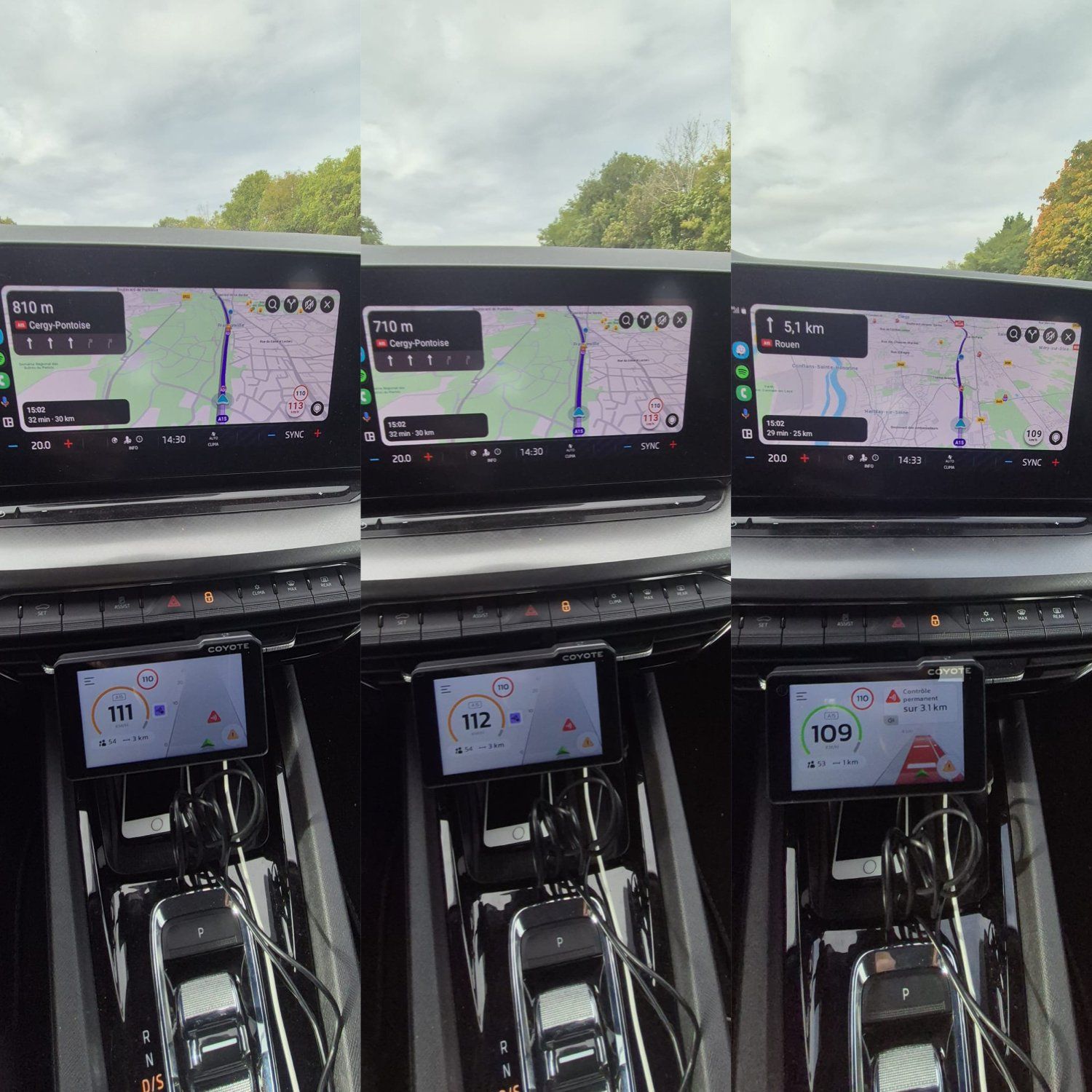
But where the Coyote Max suffers the most is in the comparison with free applications, like Waze, which offer, in addition to quality navigation, the same type of reporting as Coyote. The French brand’s argument can be summed up in one word: community. Coyote believes that its subscribers, because of their commitment, would be better able to report or confirm a danger on the road, thus making the alerts more relevant. This statement can be heard, but it remains difficult to evaluate.
For our part, we compared the Coyote Max alerts to those of Waze on several of our long journeys without noticing a real difference in performance. To put it another way, the Coyote Max didn’t tell us about a danger that Waze might have missed. Of course, the experiment would have to be extended over several weeks to have a more precise idea of these supposed differences, but at first glance the two services are on an equal footing. Therefore, the question of the price of the service arises and, unless you are a very heavy driver or someone particularly forgetful on the road, the investment in a driving assistance box seems questionable to say the least. .
Coyote Max at the best price Base price: €299
See more offers
Bilan you test:
Without a doubt, the Coyote teams worked and worked quite well to develop their new case. The Max is a more modern alert device in design and interface and a welcome update from the brand’s previous boxes. However, as successful as it is, a question remains: what is the point of having a physical box in 2024 when an application offers more or less the same thing. And above all, what is the point of paying for one or the other of these services, when free navigation applications have an almost equivalent offer. The answer to this question will undoubtedly depend on your profile and your behavior behind the wheel. But one thing is certain: with the improvement of on-board systems in cars and competition from Waze and others, Coyote must constantly reinvent itself to preserve the base of its offer, its community.
???? To not miss any news from 01net, follow us on Google News and WhatsApp.

